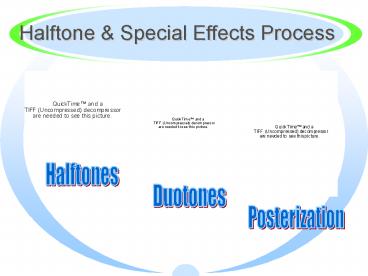Halftone - PowerPoint PPT Presentation
1 / 11
Title: Halftone
1
Halftone Special Effects Process
Halftones
Duotones
Posterization
2
Halftone Special Effects Process
Halftone comes from an old hand-engraving
process that involved breaking the image up into
quarter tones, halftones, and three-quarter tones.
Contact Screen is a series of uniform vignetted
(soft) dots mounted on a flexible support base.
Halftone contact screens can be MAGENTA or GRAY
in color.
Tint Screen is used in the platemaking process
to create the uniform tone pattern and contains a
hard dot structure that is specified by a dot
percentage
Highlight 5-10 in size. Midtone 30-70 in
size. Shadow 90-95 in size.
3
Halftone Special Effects Process
Halftone Process the procedure of converting a
continuous tone original into a pattern of dots.
Because of the nature of photographs, they cant
be printed on presses. So to print photographs,
the photo must be converted to a halftone
containing a dot pattern corresponding to the
many shades in the photo.
Halftone Reproduction the process of printing a
continuous tone image using the same
one-color-per-plate printing process.
Full color images require four plates to print
the process Yellow, Magenta, Cyan, Black.CMYK
Procesc Printing
4
Camera Copy
Line Art A drawing with no grays or middletones.
Traditionally, black lines on white paper.
Mechanical Shading Similar to line art, but has
finer details and is usually intricate in nature.
Continuous Tone an original that has not been
screened, and has infinite tone gradiations
between the lightest highlights and the deepest
shadows.
Reflection Copy an original that is opaque. It
reflects different amounts of light from the
different tone values.
Transmission/ Transparent Copy an original that
allows light to pass through it.
5
Camera Copy
Prescreened Images Camera copy that already
contain a screen or dot pattern.
Moiré Pattern A visually undesirable
dot-exaggerating effect that occurs when two
different screen patterns are randomly positioned
or superimposed.
6
Evaluating Continuous Tone Originals
Highlights the whitest tonal value.
Midtones the gray tonal values.
Shadows the darkest black tonal value.
Density the light-stopping ability of a
material--its ability to hold back or block
light.
Densitometer an electronic instrument that uses
a photocell to measure the amount of light
reflected from or passing through different tone
values.
7
Evaluating Continuous Tone Originals
High-Key Photograph contains the most important
details in the highlights, or lighter tones.
Low-key Photographs contains the most important
details primarily in the shadows, or darker tones.
8
Color Separations
Color Separation the process of using red,
green, and blue filters to divide the many colors
of an original image into the three process
colors (yellow, magenta, cyan) and black.
Screen Angles for Color Reproduction color
reproduction uses four halftone negatives, each
representing a different screen angle. Different
angles are used to eliminate or minimize the
undesirable moiré pattern. Below are listed the
different angles used for each color
Black Screen Angle 45º Cyan Screen Angle
105º Magenta Screen Angle 75º Yellow Screen
Angle 90º
9
Duotone Techniques
Duotone a special effect that consists of making
a two-color halftone reproduction from a single
color image. There are four different
classifications of duotones
- Two-impression black duotone (double-black)
- One color plus black duotone
- Color on a second color duotone
- Fake duotone
10
Posterization
Posterization the technique of changing a
black-and-white, continuous tone photo into a
multicolor or multitone reproduction. There are
four different classifications of posterization
- Two-tone Posterization
- Three-tone Posterization
- Four-tone Posterization
- Multiple-tone Posterization
11
Tone Line Process
Tone Line Process process used to convert
continuous-tone originals into line reproductions
that resemble pen-and-ink sketches or other
fine-line drawings. This process removes the
gray tone values.































